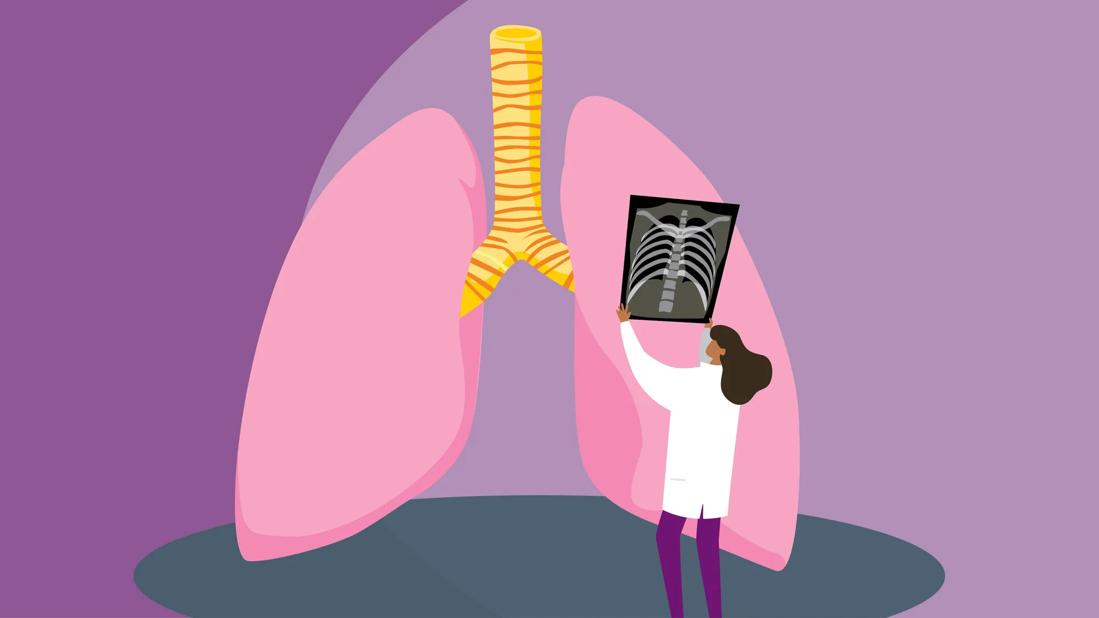Understand the symptoms and causes of these respiratory infections

At the end of a common cold, you’re ready to get on with your life. A word of warning, though: Something worse may be brewing deep in your lungs given your overwhelmed immune defenses.
Advertisement
Cleveland Clinic is a non-profit academic medical center. Advertising on our site helps support our mission. We do not endorse non-Cleveland Clinic products or services. Policy
Upper airway infections like a cold leave your lower airways more vulnerable to viruses and bacteria, and that’s when bronchitis or pneumonia can strike.
The illnesses share many similarities, yet they’re very different. To understand each of them better, let’s take a look at the causes, symptoms and treatment with pulmonologist Leslie Tolle, MD.
You know what a cold feels like, right? Well, bronchitis is that kicked up a few notches.
Bronchitis occurs when air-carrying tubes in your lungs become inflamed, often after a viral infection such as a cold or the flu, says Dr. Tolle. As these airways (called bronchioles) swell, they begin to fill with icky-and-sticky mucus.
In response, you cough… and cough… and cough. That frequent hacking often brings up that yellow-green mucus from your lungs. (That off-putting color is a key sign of infection.)
Aside from coughing, other symptoms of bronchitis may include:
There are two basic types of bronchitis — chronic and acute (short-term), explains Dr. Tolle.
Chronic bronchitis lasts for at least three months and recurs in multiple years. It can be brought on by an initial respiratory infection, exposure to tobacco smoke or other irritating things in the air around you.
Advertisement
Acute bronchitis often starts with a viral infection such as a cold. Smoking can help launch the illness and make it worse. Acute bronchitis typically lasts 10 to 14 days, with some symptoms lingering for three weeks.
Acute bronchitis can be contagious and spread by all of that coughing. It can be picked up through droplets in the air or by touching contaminated surfaces. Chronic bronchitis is less likely to be passed along.
The short-term variety of bronchitis is typically a wait-it-out illness. Over-the-counter medications might be used to help break up mucus or fight a fever or aches. Antibiotics may be prescribed if you have a bacterial infection.
Chronic bronchitis, meanwhile, is not curable. (It is classified as a chronic obstructive pulmonary disease, or COPD.) A variety of medications, therapies or even surgery might be recommended.
The best thing that you can do to help ward off bronchitis, though? Quit smoking, advises Dr. Tolle. One study estimated that 40% of smokers will develop chronic bronchitis during their lifetime.
Pneumonia is a different kind of infection that doesn’t affect the airways. Instead, it inflames the tiny sacs (alveoli) in part of your lungs, says Dr. Tolle. The swelling and resulting mucus mean oxygen and carbon dioxide can’t move as easily from the lungs to the bloodstream.
A wide variety of bacteria, viruses and fungi can cause pneumonia. Symptoms of the illness include:
Additional complications could include fluid buildup in the lungs; bacteria entering your bloodstream; or a lung abscess, which is a pus-filled cavity in the lungs.
Like bronchitis, pneumonia can be spread through droplets of fluid launched into the air when someone coughs or sneezes. You can breathe in those germs or pick them up by touching a contaminated surface.
Let’s start with this: Though there can be mild cases of “walking pneumonia,” the disease can also demand prompt medical care. Dr. Tolle says that’s even more important for at-risk groups such as:
Treatment varies based on what’s causing your pneumonia. Bacterial pneumonia is usually treated with antibiotics. Viral pneumonia, on the other hand, might be fought with antiviral medications, over-the-counter pain relievers and breathing therapy.
Advertisement
Vaccines can help protect the very young and the very old against some types of bacterial pneumonia. Quitting smoking and even avoiding lung-damaging secondhand smoke also can limit your chances of getting pneumonia.
The common symptoms of these two diseases — cough, fever, fatigue and an aching chest — are very similar. Bronchitis can even progress to pneumonia in some cases.
But these are two very different diseases affecting different parts of the lungs, says Dr. Tolle. Pneumonia symptoms also are usually much more serious and, in some cases, potentially life-threatening.
The bottom line? If you have symptoms that match either bronchitis and pneumonia and they don’t improve within a week, or if the symptoms keep worsening, contact your healthcare provider.
Advertisement
Learn more about our editorial process.
Advertisement

It’s best to treat flu-like symptoms as if you have COVID-19

For centuries, people have been drinking mullein tea for respiratory conditions

It starts off like a cold and then progresses to a rash that can last about 10 days

The short answer from an infectious disease specialist

Dry or wet, acute or chronic — it may point to a cause

Here's when to see a doctor about that persistent cough

7 ways to calm your cough

When to seek medical attention + tips for avoiding it in the first place

Type 2 diabetes isn’t inevitable with these dietary changes

Applying a hot or cold compress can help with pain